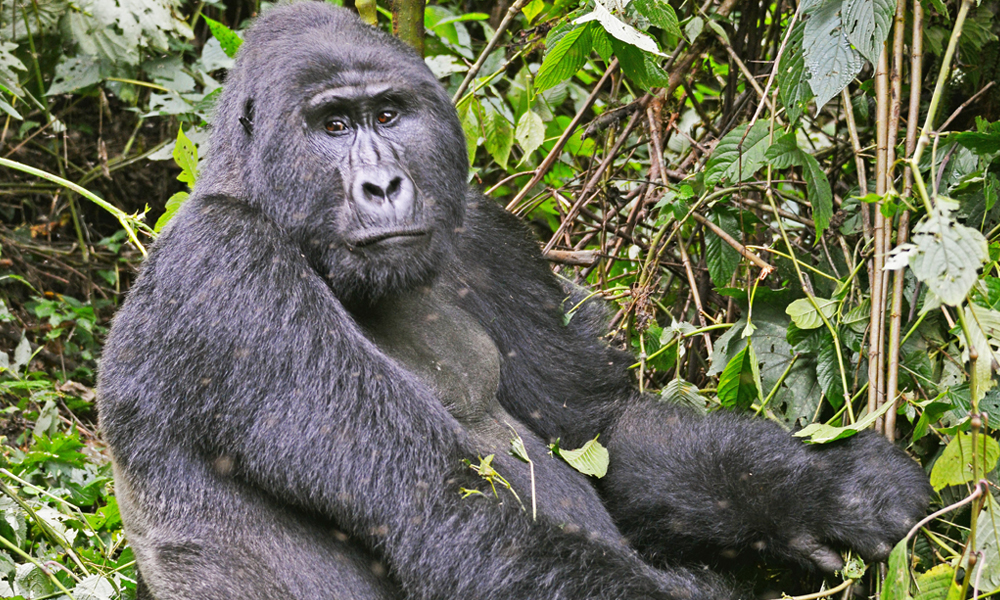Witnessing gorillas in their natural environment is a once-in-a-lifetime experience that some people claim can change their entire lives. Carefully orchestrated gorilla encounters take place as the gentle creatures go about their everyday lives. Skilled trackers and guides accompany small groups of tourists up bamboo-covered slopes to spend a priceless and breathtaking hour just a few feet away from the primates.
Gorillas, the biggest living primate, are found across most of the equatorial African rainforest. The gorilla species is often divided into two groups: lowland gorillas and mountain gorillas. The critically endangered mountain gorilla is found in the volcanic range that crosses Rwanda, Uganda, and the Democratic Republic of the Congo. In Rwanda, gorilla tracking is both safe and reasonably accessible.

There are roughly 1,000 mountain gorillas in the wild, 604 of which are located in the Virunga Massif, according to the most recent count. Because to the combined efforts of our governments, communities, and non-governmental organisations, the population is gradually growing. In the Volcanoes National Park, there are twelve completely habituated gorilla families, and a few others that are habituated only for scientific purposes. The troops, or groupings, are made up of several women and children and at least one silverback.
Start your day early with an early breakfast on the day you are going gorilla trekking. You will then be driven to Kinigi, the park headquarters. Groups of eight will be formed at the headquarters and you and the other people who are booked to go gorilla trekking that day will get safety and gorilla etiquette briefings. After that, you will be transported to the trail’s starting point, where your guide will lead you as you follow the approved trails, tracking gorillas and taking in the breathtaking scenery of the Virungas. Even at a leisurely pace, gorilla treks in the Volcanoes National Park may be quite exhausting due to their hilly nature.
In Rwanda’s Volcanoes National Park, gorilla trekking, often known as gorilla tracking, is the most well-liked pastime. Mountain gorillas are found in just three nations worldwide and are critically endangered. These three are DR Congo, Uganda, and Rwanda. There is no experience like tracking mountain gorillas on the foothills of the Virunga volcanoes. A fantastic group of rangers, guides, and porters lead the tracking and ensure that you have an amazing time. A briefing and a cup of Rwandan coffee are served at the park headquarters before the journey begins, along with entertainment from local dancers.
After that, you are taken inside the park to look for the mountain gorillas. Before seeing the mountain gorillas, gorilla trekking in Volcanoes National Park takes two to seven hours. The location of these stunning, enormous gorillas’ previous night’s nest determines how long it takes to observe mountain gorillas. You get one hour to spend with them after you meet them face to face. Being able to see them interact, eat, and play with one another is an experience of a lifetime.
It’s normal to feel a little nervous about the entire experience, especially if you have high expectations about what to expect when you eventually get to see the gorillas. Even though you’ve probably been told that gorillas are habituated, there’s a good chance you’ve never really seen one. So, while some fear is normal, try not to let it get in the way of the fun and your ability to enjoy your trip through the forest. When you eventually get up close and personal with the gorillas and realise there’s nothing to fear, your worry will probably leave. Occasionally, the mischievous kids may venture closer than anticipated, but as long as you adhere to your tour guide’s directions, everything will work out great.
Since each soldier only receives eight tracking licences every day, the interaction is as private and inconspicuous as possible. It is strongly advised to make reservations in advance, either online or through a reliable tour operator, as there are only 96 permits available every day in Rwanda. Susa, Igisha, Karisimbi, Sabyinyo, Amahoro, Agashya, Kwitonda, Umubano, Hirwa, Bwenge, Ugyenda, and Muhoza are the names of the families.
Ten percent of the permits’ income is used to fund road construction, school and health centre construction, and other community projects. To help promote peaceful coexistence, local farmers are provided with a compensation fund in the event that gorillas damage their crops. Many locals are employed in gorilla tracking as well, including rangers, trackers, porters, drivers, and employees of tourist hotels. To follow in Dian Fossey’s footsteps, drive for thirty minutes from the park headquarters to her tomb, then walk for two or three hours through the jungle to an elevation of over 3,000 metres.
